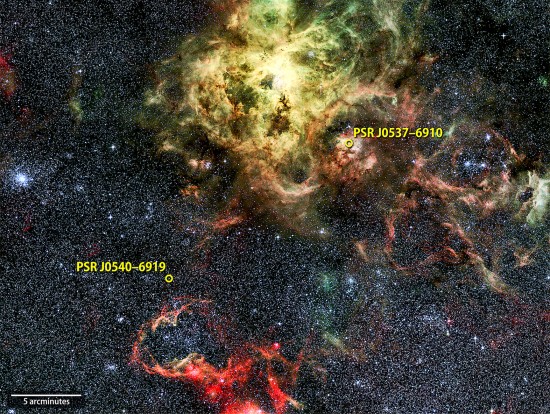
Location of two pulsars in the Tarantula Nebula. Credit: NASA’s Goddard Space Flight Center; background: ESO/R. Fosbury (ST-ECF).
Nov 13, 2105
Electrical effects drive pulsars.
When any charged particle follows a curved trajectory, or is accelerated in a straight-line, it will emit electromagnetic radiation, otherwise known as synchrotron radiation. Synchrotron radiation creates X-rays and gamma-rays, a phenomenon demonstrated in laboratory experiments.
Gamma-rays are a class of theoretical “electromagnetic particles” called photons. Photons have no physical mass calculations, so they travel at enormous velocity—up to 2.993 x 10^10 centimeters per second. That high velocity increases their inertia, enough for them to knock electrons out of an atom, which ionizes the material.
Since gamma-rays are capable of penetrating the space between atoms (wavelengths of 0.1 nanometers), densely packed crystals make up gamma-ray detectors. So, when they ionize particles in the crystal matrix, the particles emit electrons through a process known as Compton scattering. It is the electrons that are seen and not gamma-rays, themselves.
NASA launched the Fermi Gamma-Ray Space Telescope on June 11, 2008. Its primary mission is to map extremely high frequency electromagnetic energy, especially gamma-rays. Although gamma-rays are said to travel up to billions of light-years through space, they are unable to penetrate Earth’s upper atmosphere, so Fermi is in an orbit outside the regions of greatest density.
According to a recent press release, Fermi detected a spike of gamma-rays coming from the Tarantula Nebula in the Large Magellanic Cloud, making it the first “…extragalactic gamma-ray pulsar”. The pulsar, called J0540 is said to be spinning at 19 times per second, nearly as fast as the blades in a kitchen blender.
Pierrick Martin, an astrophysicist at the National Center for Scientific Research (CNRS) and the Research Institute in Astrophysics and Planetology said:
“It’s now clear that a single pulsar, PSR J0540-6919, is responsible for roughly half of the gamma-ray brightness we originally thought came from the nebula. That is a genuine surprise.”
As written elsewhere, Hannes Alfvén’s understanding of high energy cosmic physics was that the “exploding double layer” should be considered a new class of celestial object. Compression zones (z-pinches) in plasma filaments create plasmoids that evolve into stars and galaxies. Electricity drives the stars, and when current density gets too high, double layers in the circuit catastrophically release their excess energy, appearing as pulsar GRBs, X-ray emissions, or flares of ultraviolet light.
Conventional astrophysics assumes that pulsars are neutron stars with magnetic fields measuring over 10^15 Gauss. Earth’s magnetic field is about one-half Gauss, in comparison. However, the magnetic evidence is indirect, since no neutron star has ever been observed. Intense magnetic fields are observed to pulse in fractions of a second, so there must be an electric current generating them in a pulsar. The “feeder current” must be part of a circuit, as well, since persistent electric charge must complete a circuit.
In the Electric Star theory, it is logical that resonant effects in electric circuits are responsible for the oscillations in pulsars. A catastrophic release of electricity in a double layer causes their outbursts. Those outbursts begin with a sudden peak of energy, and then gradually decline, like a stroke of lightning.
Stephen Smith












